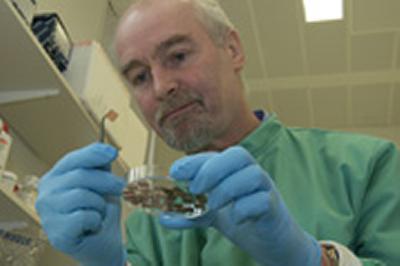New study shows how copper restricts the spread of global antibiotic-resistant infections

New research from the University of Southampton has shown that copper can prevent horizontal transmission of genes, which has contributed to the increasing number of antibiotic-resistant infections worldwide.
Horizontal gene transfer (HGT) in bacteria is largely responsible for the development of antibiotic-resistance, which has led to an increasing number of difficult-to-treat healthcare-associated infections (HCAIs).
The newly-published paper, which appears in the journal mBio, shows that while HGT can take place in the environment, on frequently-touched surfaces, such as door handles, trolleys and tables, which are made from stainless steel – copper prevents this process from occurring and rapidly kills bacteria on contact.
Lead author Professor Bill Keevil, Chair in Environmental Healthcare at the University of Southampton, explains: “Whilst studies have focussed on HGT in vivo (an experiment that is done in the body of a living organism), this work investigates whether the ability of pathogens to persist in the environment, particularly on touch surfaces, may also play an important role. Here we show prolonged survival of multidrug resistant Escherichia coli and Klebsiella pneumoniae on stainless steel surfaces for several weeks. However, rapid death of both antibiotic-resistant strains and destruction of plasmid and genomic DNA was observed on copper and copper alloy surfaces, which could be useful in the prevention of infection spread and gene transfer.”
Showing that horizontal transmission of genes (for example, those governing antibiotic resistance) occurs on touch surfaces, supports the important role of the environment in infection prevention.

Professor Keevil summarises: “We know many human pathogens survive for long periods in the hospital environment and can lead to infection, expensive treatment, blocked beds and death. What we have shown in this work is the potential for strategically-placed antimicrobial copper touch surfaces to not only break the chain of contamination, but also actively reduce the risk of antibiotic resistance developing at the same time. Provided adequate cleaning continues in critical environments, copper can be employed as an important additional tool in the fight against pathogens.”
Beyond the healthcare environment, copper also has a wider role to play in infection control. Professor Keevil explains: “Copper touch surfaces have promise for preventing antibiotic resistance transfer in public buildings and mass transportation systems, which lead to local and – in the case of jet travel – rapid worldwide dissemination of multi-drug resistant superbugs as soon as they appear.
“People with inadequate hand hygiene could exchange their bugs and different antibiotic resistance genes just by touching a stair rail or door handle, ready to be picked up by someone else and passed on. Copper substantially reduces and restricts the spread of these infections, making an important contribution to improved hygiene and, consequently, health.”
Installations of copper touch surfaces have already taken place across the UK and around the world, harnessing copper’s ability to continuously reduce bioburden and consequently the risk of HCAI transmission. This research offers additional evidence to deploy copper (and copper-containing alloys that benefit from the metal’s antimicrobial properties) in the form of touch surfaces to provide extra protection alongside standard hygiene practices.